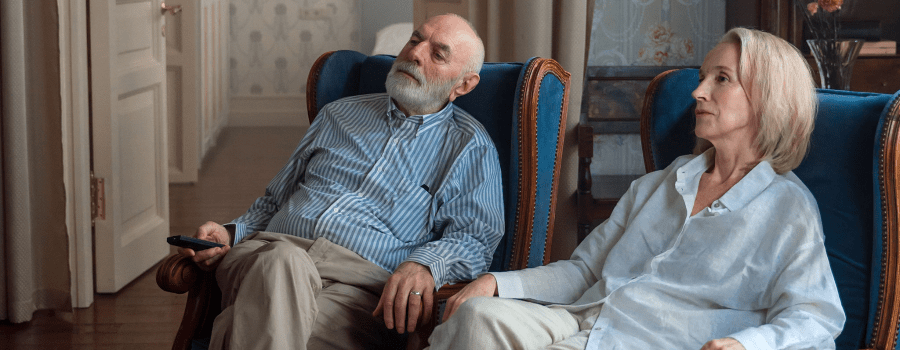Why is TV an Influence on Baby Boomers?
Baby boomers watch a lot of TV.
Television is not only a huge part of the baby boomer experience but also drives purchase and voting decisions.
- What is a baby boomer?
- How much time do boomers spend watching TV?
- What do baby boomers watch?
- Why do baby boomers watch TV?
- Does TV viewing influence voting & purchase decisions?
My intention is not to be hostile toward the baby boomer generation. Gen Z (my generation) takes the things we read on Instagram, Twitter, or Snapchat news as gospel truth. My only motivation is to collect data and apply observation.
What is a baby boomer?
“Baby boomer” is a generational nickname for a person born between 1946 and 1964, putting the technical age range today from 57-years-old to 75-years-old. Baby boomers received this nickname due to the demographic population increase after WWII vets returned from war and had children.
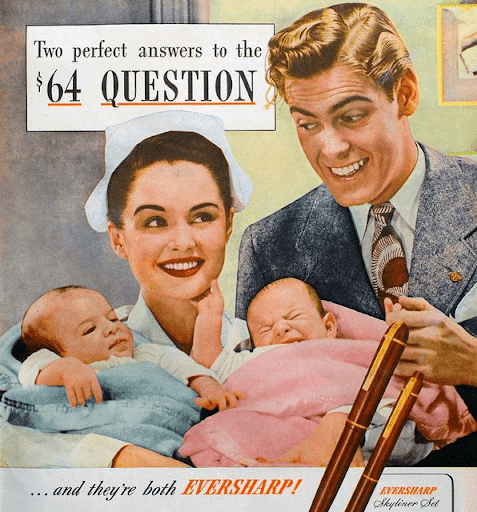
Baby boomers are the largest generational group in U.S. history.
This article will be using the term “baby boomer” in a less rigid sense than simply being born between 1946 and 1964. A person could fall slightly outside of the technical age range, but still contain the characteristics of a boomer.
How much time do boomers spend watching TV?
In 2019 (pre-Covid-19 pandemic), data was released showing the average daily time spent watching TV per capita in the United States, from 2009 to 2019.
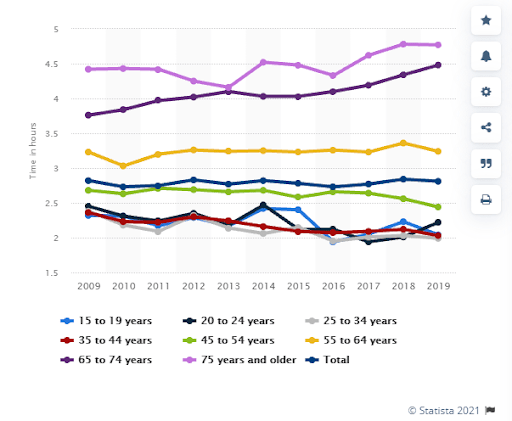
The 65 to 74 year old demographic watched 4.48 hours of TV every day. This TV time is double what Gen X, Millennials, and Gen Z watched over the same time period.
Nielsen showed this TV viewing time increased during the 2020 Covid pandemic. Adults 65 and older viewed over 7 hours of TV per day.
According to Nielsen, those in the 65+ age group were the only demographic group to increase their total traditional TV viewing during Q3 of 2020. Baby boomers watched over 7 hours of TV per day in 2020.

What do they watch?
One can think of two broad categories for TV: contemporary and news.
Contemporary TV includes sports, dramas, crime shows, comedy, and cooking shows.
News TV is anything considered political or newsworthy, including cable news, local news, and government channels such as CSPAN.
Contemporary TV
Baby boomers tend to prefer game shows, old reruns, and crime shows.
Jeopardy is considered to be the most popular contemporary TV show, popular with 74% of baby boomers according to YouGov. This was followed by Perry Mason, Wheel of Fortune, 60 Minutes, and Antiques Roadshow.
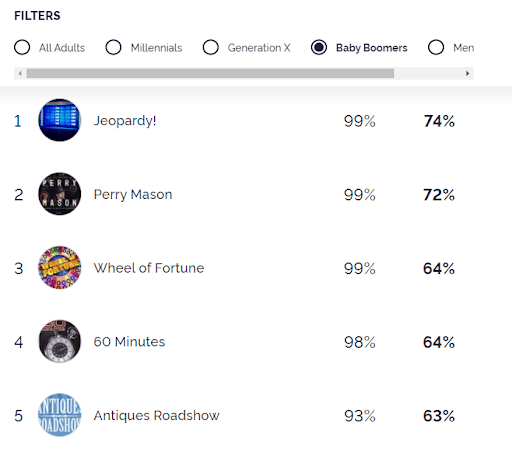
During the Covid-19 pandemic, baby boomers’ favorite TV show was the “NCIS” franchise.
News TV
Out of all age categories, baby boomers consume TV news at the highest rate. 51% of baby boomers watch TV to consume news and information about the world.
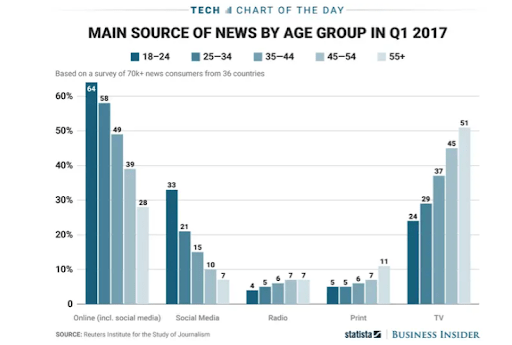
News Channels Watched
Pew Research asked baby boomers what sources they (a) get the news from and (b) trust.
Top 10 Sources of News for Baby Boomer Generation
| Source | % of Boomers who got news about politics and government in the previous week from each source |
|---|---|
| Local TV News | 60 |
| Fox News | 47 |
| NBC News | 47 |
| ABC News | 44 |
| CNN | 43 |
| CBS News | 39 |
| 39 | |
| MSNBC | 33 |
| PBS | 26 |
| NPR | 22 |
Boomers watch local news broadcasts most of any other broadcast. 60% of baby boomers report getting news about politics and government from local TV broadcasts. This is important and we will touch on this later.
Top 10 News Sources Boomers “Trust”
| Source | % of Boomers saying they trust each source |
|---|---|
| ABC News | 53 |
| NBC News | 53 |
| Fox News | 51 |
| CBS News | 50 |
| CNN | 50 |
| PBS | 42 |
| MSNBC | 39 |
| BBC | 35 |
| USA Today | 35 |
| Wall Street Journal | 34 |
News Sources by Political Affiliation
Pew Research also asked about news TV consumption alongside political party affiliation.
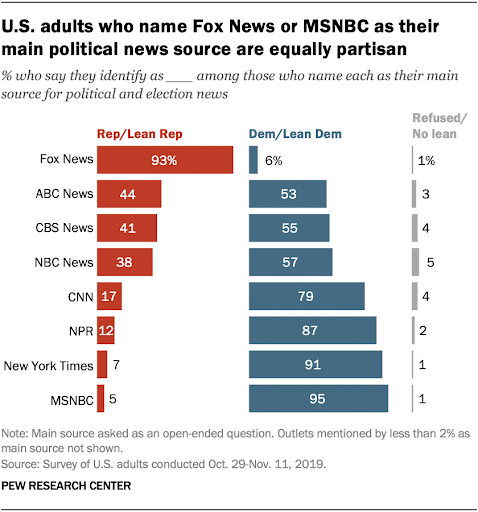
Fox News is considered to be a main source of information for self-identified Republicans, while MSNBC is the main source of information for self-identified Democrats. Regardless of political affliction, U.S. adults watch “mainstream” outlets like ABC, CBS, and NBC.
Why do they watch TV?
The invention of the television dates back as far as 1927, when Philo Farnsworth transmitted the image of a line to a receiver in the same building.
TV continued to improve through the decades, gaining social and cultural significance.
During the late ‘40s, and into the ‘50s and ‘60s, the TV became a household experience. Networks started producing children’s shows to target these young boomers, including “Howdy Doody”.
Cultivation Theory
Cultivation Theory is the idea that long-term exposure to media shapes how consumers of the media perceive the world and conduct themselves.
This is a way to explain the motivations of people who control mass media. Those who wield the information monopoly, wield the cultural power.
Baby boomers watching TV as children
A study conducted by Jenny Herring as a graduate project at Iowa State University interviewed 31 baby boomers. Discussions took place over the phone or in person. Each interview took around an hour to complete.
Baby boomers were asked how much TV they had watched per day growing up. Since specific data could not be gathered, the study had to rely on the participants’ memory. The results are below.
| Respondents | Hours of TV per day, self-reported |
|---|---|
| 21 | 1-2 hours |
| 5 | 2-3 hours |
| 3 | 3-4 hours |
| 2 | 4-6 hours |
| 31 total |
The total TV time watched is considerably lower when compared to other sources.
In his book Baby Boomers, NYU professor Paul C. Light suggests TV has had an outsized influence on baby boomers; “By the time the average baby boomer reached age 16, he or she had watched from 12,000 to 15,000 hours of TV, or the equivalent of 24 hours a day for 15 to 20 solid months”.
TV as a shared cultural experience
The medium of TV is naturally unifying. Compared to the options of youth today (with millions of YouTube channels, streaming options, etc), baby boomers all watched the same handful of programs.
The TV allowed baby boomers to have a shared cultural experience. They often reference watching the same programs during their formative years, going into adulthood.
In the same Iowa State study, baby boomers made several references alluding to the TV forming the way they experienced the world:
“They (the McCarthy camp) wanted him assigned to the New York area so he could continue to work part-time for them. The Army wouldn’t allow it. So McCarthy accused the Army of having Communists. The entire time was a witch-hunt.”
Male respondent on watching Army-McCarthy hearings on TV
“I think what they probably did was just make me question more. I think the turbulence that went on through the ‘60s and ‘70s, kind of coming of age during that period of time, it made me question things more. They made me realize that life wasn’t just as kind of routine as maybe what I was exposed to. I experienced the conservatism of the 1950s and the ‘60s. It was very stifling, and seeing these things, certainly the Vietnam War you saw on TV, really allowed me to realize hey, there’s different ways. There’s stuff that’s going on that shouldn’t happen, I don’t have to feel like I’m a bad guy if I’m outside the lines a little bit. There’s terrible things that go on in this world and you better be aware of it.”
Male respondent on social and historical events viewed on TV as an adolescent
“The combination of Martin Luther King and then Bobby Kennedy (being assassinated) in such a short amount of time, I had this consciousness thing that happened. I started realizing there’s something really wrong. I became very upset about that, upset about the war, upset about the way my parents’ generation were feeding the stereotype of my generation and slightly over as ‘blankety-blank worthless hippies, etc.’
Female respondent on the TV events of ’60s and ’70s
Even in the “old days” of the 50s and 60s, TV networks understood they could affect the public perception of an entire generation. They would leverage this power by presenting events of the country in a specific light.
Does TV influence the purchases and voting decisions of Baby Boomers?
Watching TV cannot convince every person of a generation to believe the same ideas. People make their own decisions.
However, media does affect the framing and perception of events. Since certain events can only be seen through the lens of a camera, the person filming can choose what to show and how to show it.
A piece of media can be 100% accurate but mislead viewers due to lack of context.
TV influencing baby boomers purchase decisions
Baby boomers control 70% of all disposable income in the United States. They also make up 58% of retail sales, despite making up 21% of the overall U.S. population.
Thus, it’s worthwhile to understand how boomers spend money.
According to Clutch, Boomers have low trust in TV ads, compared to Millennials.
TV influencing baby boomers voting decisions
Local news is deeply trusted by baby boomers
Statista reports that 75% of adults 55 and older trust “local television news from TV stations in my area”.
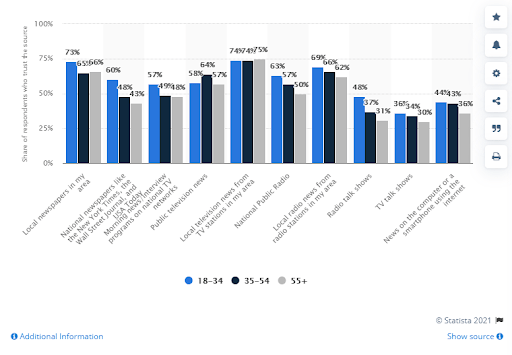
75% of adults 55 and older trust “local television news from TV stations in my area”.
Statista
Older Americans trust the media they watch most often
Baby boomers tend to place more trust in the news media than younger generations. They are also more likely to trust the media source they use most often.
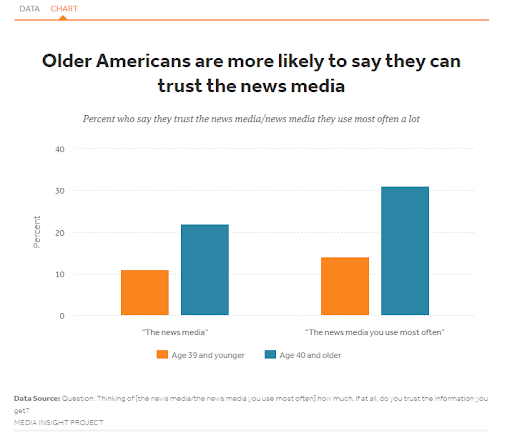
Cultivation Theory on Boomers Political Decisions
If one subscribes to some aspects of cultivation theory, you can assume a continual diet of a media source would affect (at the very least) a boomer’s perspective, and even their voting persuasion.
Older Americans trust the news media they use most often. What news sources do they use most often? Local news broadcasts.
I believe local news stations have the most trust, and thus the most power of any institution over the boomer generation.
But wasn’t the election of Donald Trump powered by baby boomers and older Americans?
While it’s true older Americans comprised the largest voting base for Donald Trump, a shift from Donald Trump to Joe Biden in 2020 is part of the reason Donald Trump lost the election.
There are a couple of important aspects that are ignored:
- The media framed Donald Trump as clownish and unserious in 2016; whereas the media framed Donald Trump as dangerous and unhinged in 2020. This distinction is important when it comes to a huge issue like Covid-19.
- Covid-19 played a huge role in how older Americans perceived the 2020 election. Local news media would often lead with Covid-19 related cases and death counts. This framed how older Americans perceived both 2020 presidential candidates.
- Media influence only needs to be marginal to have an effect. The news media does not have to get 90% of Americans to agree on an issue to have an effect on electoral politics. By swinging a small percentage of a voting group, you can affect an entire election. The graph below shows the shift of voters in the 50-64 age range and 65+ age range toward Joe Biden in 2020 vs Hillary Clinton in 2016.
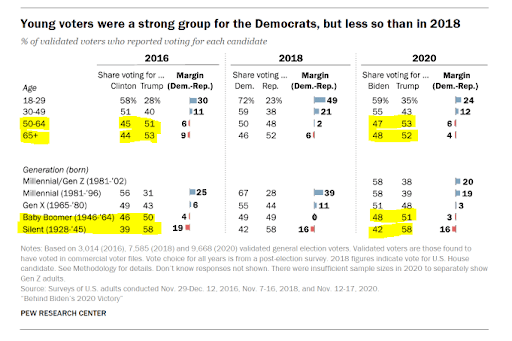
Much of this swing is due to local news coverage of Covid-19 setting the framing for the “careful” and “thoughtful” Joe Biden regarding Covid-19 response.
Conclusion
Television was a formative piece of technology for the baby boomer generation. It defined how this generation perceived the world from childhood, through adulthood, and into the modern age. TV is the most popular form of media consumption by baby boomers. As a result, this has an influence on the purchase and voting decisions of baby boomers.
Hi there! Did you enjoy this article? Subscribe to our mailing list so we don't lose touch!

